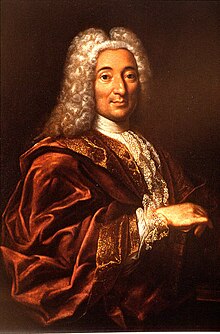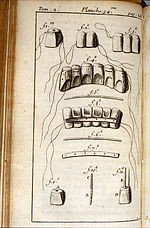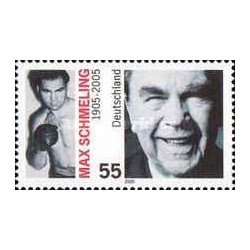- جدید
- ناموجود



توجه : درج کد پستی و شماره تلفن همراه و ثابت جهت ارسال مرسوله الزامیست .
توجه:حداقل ارزش بسته سفارش شده بدون هزینه پستی می بایست 100000 ریال باشد .
توجه : جهت برخورداری از مزایای در نظر گرفته شده برای مشتریان لطفا ثبت نام نمائید.
| Pierre Fauchard | |
|---|---|

Portrait of Fauchard by J. Le. Bel
|
|
| Born | circa, 1678 Saint-Denis-de-Gastines, France |
| Died | March 22, 1761 (aged 83) Paris, France |
Pierre Fauchard (1678 – March 22, 1761) was a French physician, credited as being the "father of modern dentistry".[1] He is widely known for writing the first complete scientific description of dentistry, Le Chirurgien Dentiste ("The Surgeon Dentist"), published in 1728.[1] The book described basic oral anatomy and function, signs and symptoms of oral pathology, operative methods for removing decay and restoring teeth, periodontal disease (pyorrhea), orthodontics, replacement of missing teeth, and tooth transplantation.
Fauchard was born in a very modest home in Saint-Denis-de-Gastines in 1678. In 1693 he joined the French Royal Navy at the age of 15, much to his family's distress, and came under the influence of Alexander Poteleret, a surgeon major, who had spent considerable time studying diseases of the teeth and mouth.
During that time, Fauchard learned that sailors who were on long voyages suffered severely from dental ailments, scurvy in particular. Eventually Major Poteleret inspired and encouraged him to read and carefully investigate the findings of his predecessors in the healing arts. He said he wanted to disseminate the knowledge he learned at sea based on actual practice. This idea led Fauchard to become a combat medic as Poteleret's protégé.
Once Fauchard left the navy, he shortly settled down in Angers, where he practiced medicine at the University of Angers Hospital. In Angers, he started much of the revolutionary medical work we know today, and he was the pioneer of scientific oral and maxillofacial surgery. Fauchard often described himself as a "Chirurgien Dentiste" (surgical dentist), a term very rare at the time as dentists in the 17th century generally extracted decayed teeth rather than treating them.
Despite the limitations of the primitive surgical instruments during the late 17th and early 18th century, Fauchard was considered a highly skilled surgeon by many of his colleagues at Angers University Hospital. Fauchard made remarkable improvisations of dental instruments, often adapting tools from watch makers, jewelers and even barbers, that he thought could be used in dentistry.
Fauchard introduced dental fillings as treatment for dental cavities. He asserted that sugar derivate acids like tartaric acid were responsible for dental decay, and also suggested that tumors surrounding the teeth, in the gums, could appear in the later stages of tooth decay.
Fauchard was the pioneer of dental prosthesis, and he discovered many methods to replace lost teeth. He suggested that substitutes could be made from carved blocks of ivory or bone and those artificially-made dental pieces would be useful as the natural ones. One of this methods stated that the artificial teeth would be held in place by tying them to the remaining solid teeth by pivots, using waxed thread or gold wire. He also introduced dental braces, although they were initially made of gold, he discovered that the teeth position could be corrected as the teeth would follow the pattern of the wires. Waxed linen or silk threads were usually employed to fasten the braces.
During 1716 to 1718, Fauchard gained great prestige. During that time he spent long periods away from home studying and sharing his medical practice with other surgeons across France.
In 1718, Fauchard moved to Paris. During his stay in that city, Pierre realized that many medical libraries lacked good textbooks on dentistry and that an encyclopedic teaching book of oral surgery was needed, so he made the decision to write a professional dentist's treatise based on his medical experience.
For many months Fauchard gathered as many medical research books as he could, interviewed the many dentists he had met, and reviewed his personal diaries during his years at Angers to write his manual. Finally in 1723, at the age of 45, he completed the first 600-page manuscript for "Le Chirurgien Dentiste" (roughly translated as "The Surgical Dentist"). Fauchard sought further feedback from his peers over the next five years, and the manuscript had grown to 783 pages by the time it was published in 1728 in two volumes.[1] The book was well received in the European medical community.[1] An enlarged edition in French was published in 1746 and a German translation was available in 1773.
The book consisted of 38 chapters in volume 1 and 26 chapters in volume 2. Both volumes contained 42 plates depicting surgical instruments and appliances. Many of the ideas introduced in the book were totally new to dentistry.[2] Pierre Fauchard engraved in his books many of his inventions of instruments made for oral surgery, such as the obturator and the now famous dentist's drill. The drill Fauchard developed was manual and powered by a catgut twisted around a cylinder. He also suggested in his book that oil of cloves and cinnamon be used for pulpitis.[2]
Fauchard recommended that human urine be used in the treatment of early stages of caries.[2] A chemical compound that he was not able to identify in urine at the time was ammonia, which was responsible for the "beneficial result" of urine. Although urine had been used for this purpose since the ancient times to Middle Ages, the treatment met with resistance by many physicians and patients.
In his book and all his life Fauchard denounced the quackery and fraud of dental charlatans and their exploitation of patients. Pierre advised his students and friends of the highly injurious techniques used by charlatans and to avoid them. He warned his medical readers that nitric acid and sulfuric acid on teeth to remove tartar used by charlatans were potentially dangerous and explained how to identify their false dental fillings.[2] One of the first physicians to denounce medical malpractice in dentistry, he alleged to a tribunal that many dentists in France did not have a degree or experience.[3]
Fauchard became a model for all dentists to come. He died at the age of 83 in Paris on March 22, 1761.
Fauchard's work influenced many young medical minds in the age of enlightenment in France, Robert Bunon (1702–1748)a dentist like Pierre, spent many years of his life in enamel hypoplasia research.[3]
Etienne Bourdet (1722–1789), who is said to be one of France's best dentists after Fauchard, based his work mainly on dental prosthesis (a concept introduced by Pierre), he also improved the way the amalgams were made and was the first physician to do gingivectomy on his patients when required.[3]
The American 19th-century dentist Chapin A. Harris often quoted him and said that "considering the circumstances and limitations of his time, he will always be remembered as a pioneer and founder of modern dentistry."[3]
Although Fauchard's famous dental treatise on dentistry was published in the 18th century, it was not until 1946 when Lilian Lindsay a medical science historian published a translation in the English language.[3]
تشکر نظر شما نمی تواند ارسال شود
گزارش کردن نظر
گزارش ارسال شد
گزارش شما نمی تواند ارسال شود
بررسی خود را بنویسید
نظر ارسال شد
نظر شما نمی تواند ارسال شود

check_circle
check_circle




















